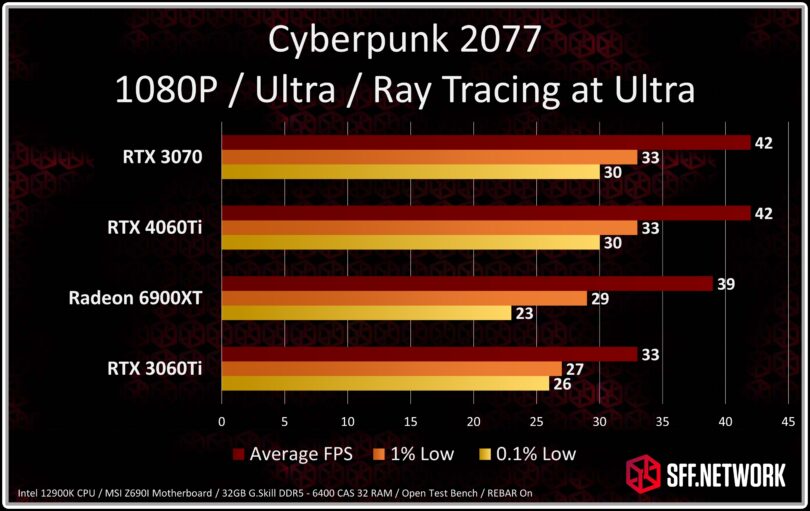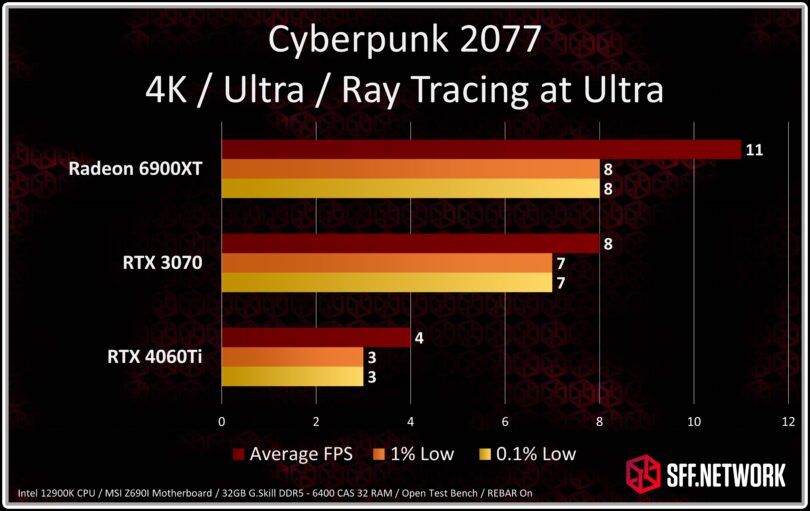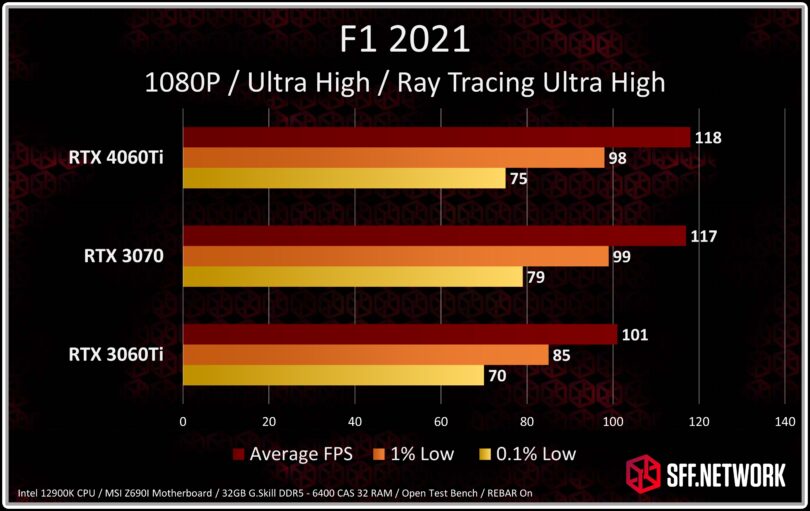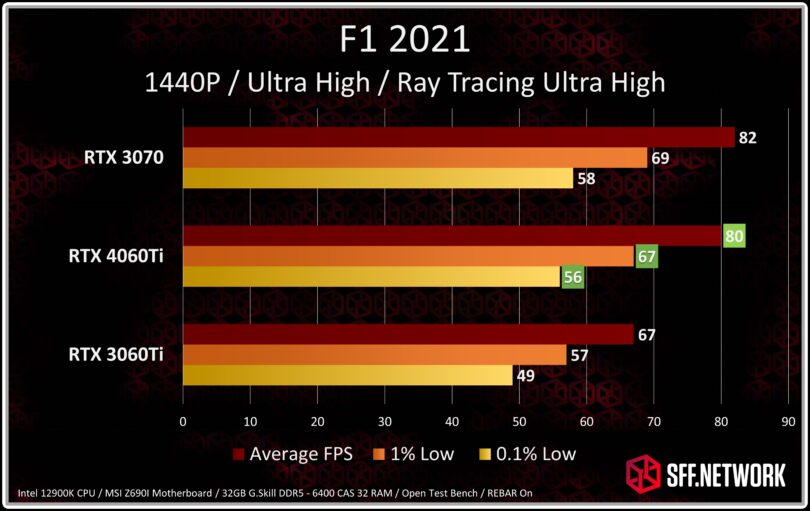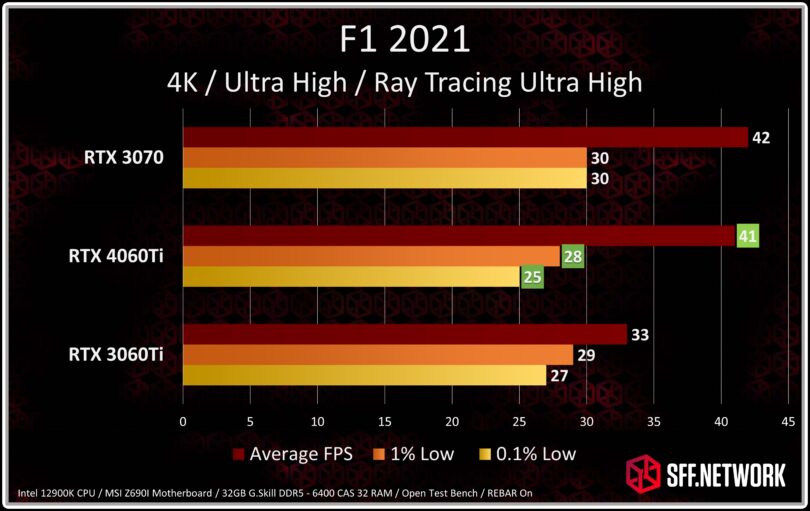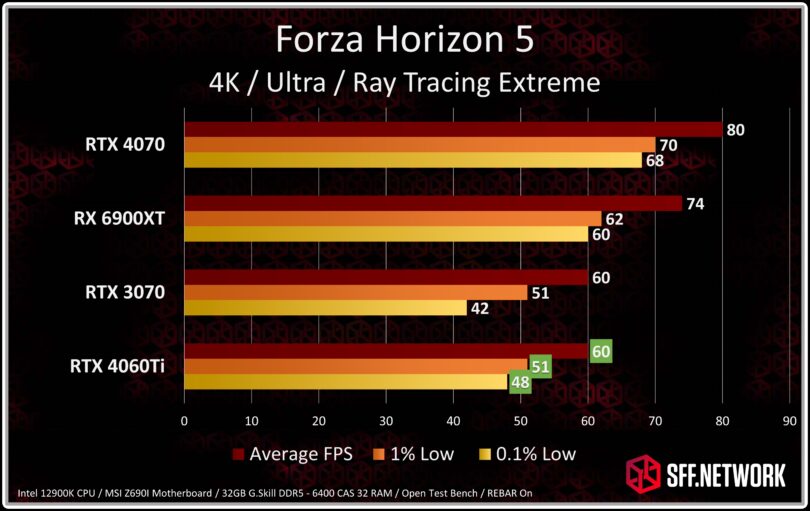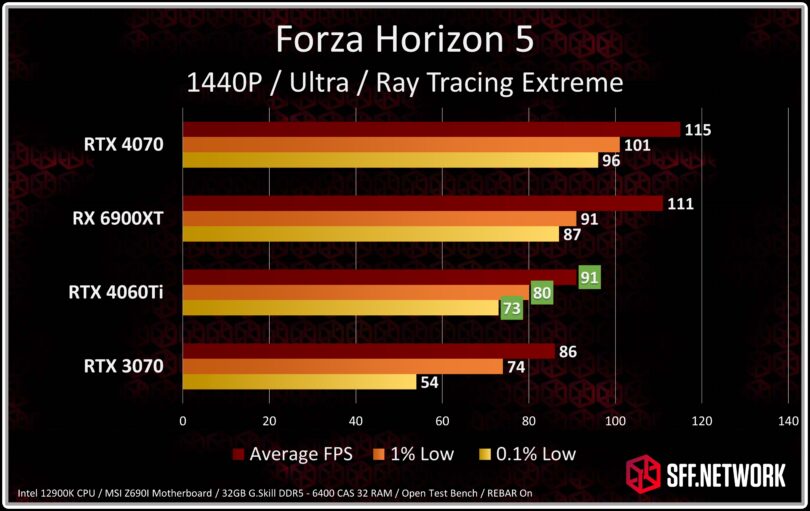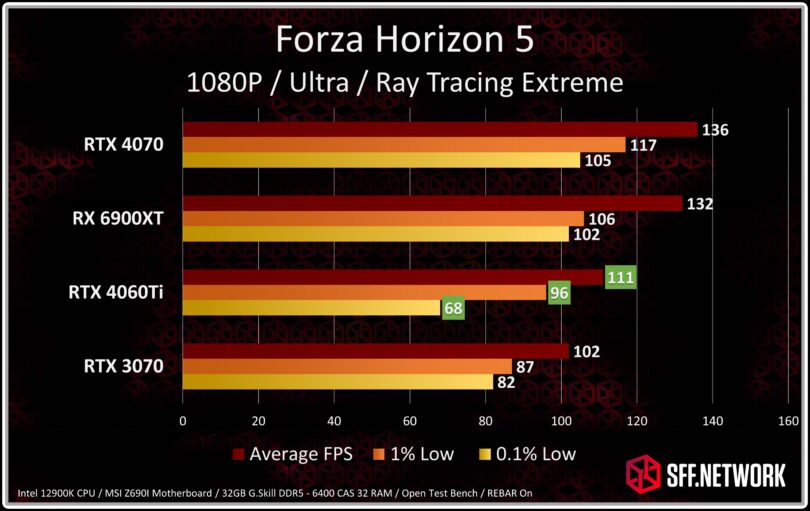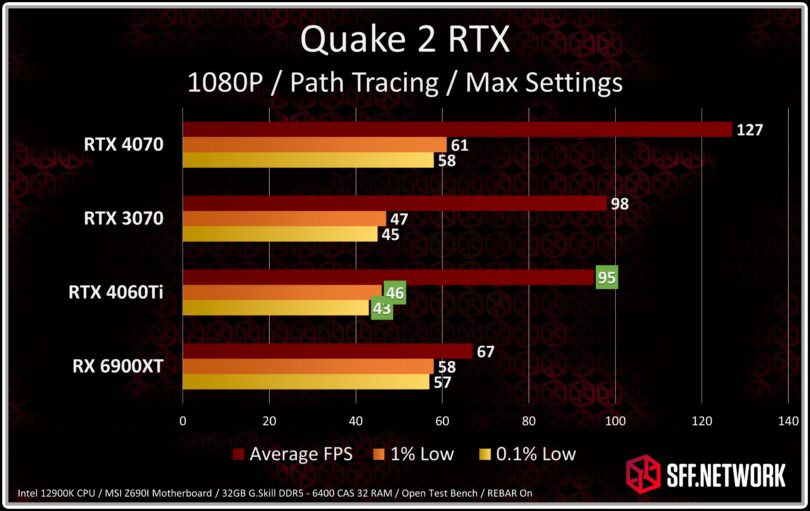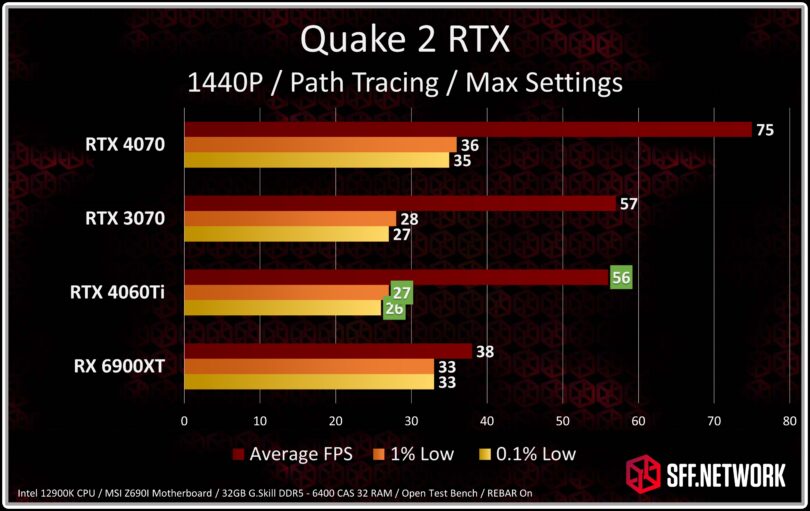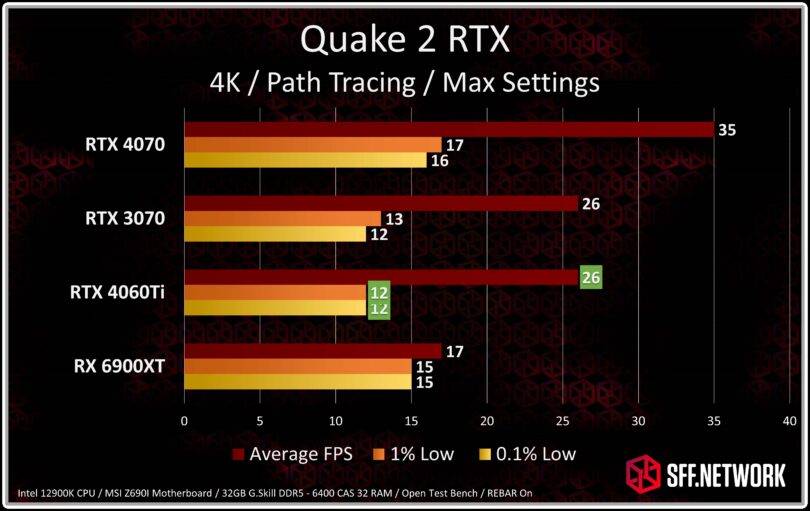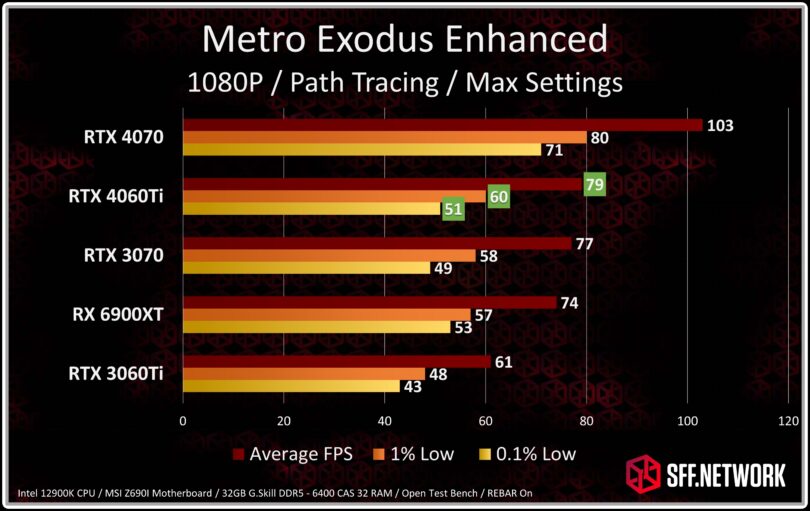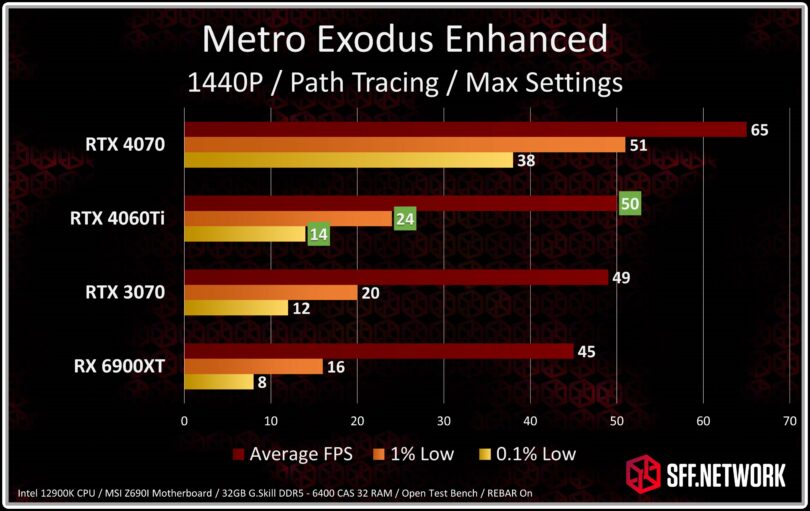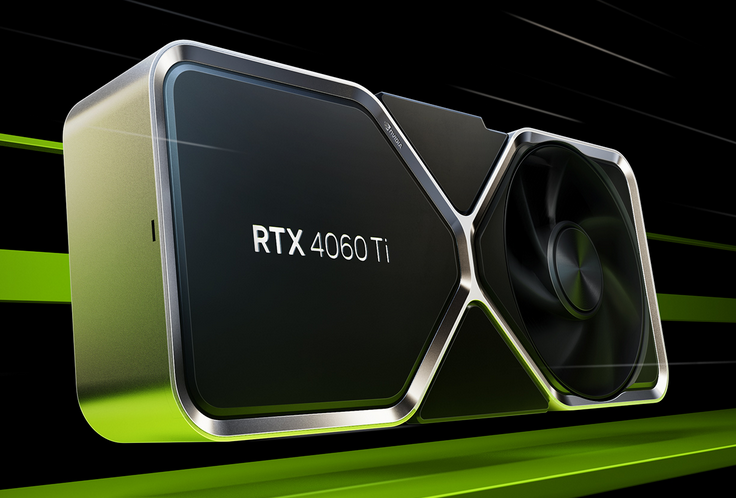
This is part 2 of our RTX 4060Ti review where we look at the RTX 4060Ti’s Ray Tracing performance. To see part 1, CLICK HERE.
Ray Tracing
Ray tracing has become an important performance metric over the last five years as it slowly supplants older reflection and ambient occlusion technology. Unfortunately, it still carries a hefty performance penalty. Using upscaling technology such as DLSS, FSR, and XESS does help mitigate some of the performance loss, but they aren’t magical fixes to the issue.
Ray tracing is also done in two methods currently. There is the hybrid approach where ray tracing is used to augment existing techniques such as screen space, and there is the path tracing approach where ray tracing is the sole source of lighting and reflection information. Path tracing is extremely cost prohibitive when it comes to performance with even the RTX 4090 failing to achieve good native frame rates in modern path traced titles such as Cyberpunk 2077 without upscaling technologies. However, there is an emergence of older titles being remastered with path tracing. Quake 2 was one of the first to arrive with a full path tracing system. Portal is the latest path tracing remaster to garner attention.
Ray Tracing Test Game Engines and Games
Our ray tracing test are divided into hybrid system and path traced games.
Hybrid Games
- REDengine 4 – Cyberpunk 2077
- Ego – F1 2021 / F1 2022 (Note: F1 2022 benchmarks have not been added to all cards yet).
- ForzaTech – Forza Horizon 5
These engine tests are at the maximum ray tracing settings prior to path tracing.
Path Traced Games
- Quake 2 Engine – Quake 2 RTX Edition (Note: It is not exclusive to Nvidia cards)
- 4A Engine – Metro Exodus Enhanced Edition
These engines are path traced and set to highest available settings.
On occasion, we may include performance numbers from other games. However, they are not part of our official testing suite until they are well patched and drivers have been optimized for them. Additionally, we have removed games that use simplified ray tracing such as Dirt 5 and Shadow of the Tomb Raider for ray tracing tests as they are not examples of the technology’s current use, and are of very limited value.
Hybrid Ray Tracing Performance
As mentioned before, these games use a mix of rasterization techniques and ray tracing techniques.
Cyberpunk 2077 – RT Ultra
These numbers are not a typo. The RTX 4060Ti did really tie the RTX 3070 in all of our metrics, and offered a 27% uplift over the RTX 3060Ti . The Radeon 6900XT wasn’t far behind on the average performance, but its 1% and 0.1% low performance suffered.
At this point showing 1440P and 4K numbers is pointless with this group of GPUs as they would only be good for looking at and comparing them to GPUs that launch in 10 years form now, and run these games in the 100s of FPS. Anything above 1080P was unplayable.
However there was an interesting thing that occurred at 4K that warrants taking a look at.
In this rare instance we see a perfect example of the power of VRAM and bus width. The Radeon 6900XT is by no means faster at ray tracing than the RTX 3070 or RTX 4060Ti in this title, but does have 16GB of memory compared to their 8GB. This granted it a 38% performance improvement over the RTX 3070, and a 175% increase over the RTX 4060Ti.
The RTX 4060Ti comes in last due to its 128 bit bus being unable to cope with the large amount of memory usage necessary for these settings. Had it had a 256 bit bus, it most likely would be tied again with the RTX 3070.
In essence, this is showing that the 32MB of cache included on the RTX 4060Ti simply can’t replace the wider bus when pushed to the limit, leading us to the old saying that “there is no replacement for displacement”.
F1 2021 – Ultra High Ray Tracing
Regardless of if there is a perceived visual improvement to the games graphics, F1 2021 ray tracing settings do effect performance.
RT performance for the RTX 4060Ti at 1080P is neck and neck with the older RTX 3070, and offers a 17% improvement over the RTX 3060Ti.
At 1440P we see more of the same. The RTX 3070 and RTX 4060Ti are still within a few frames of each other, and the RTX 4060Ti is 19% faster than the RTX 3060Ti.
Finally we have 4K. The game looks good on all of these cards, but feels like a retro console game with only the RTX 3070 being able to pull a solid 30FPS experience. The RTX 4060Ti has strong averages, but falls well behind the RTX 3070 and even the RTX 3060Ti when it comes to 1% and 0.1% lows. Five whole FPS difference between the RTX 3070 and RTX 4060Ti might not seem like much in the 0.1% lows, but at these already low frame rates that means the RTX 3070 is putting out 20% faster 0.1% lows.
So for F1 2021 with ray tracing, the RTX 4060Ti is a 1080P card when settings are maxed out, and can provide a good experience at 1440P with a few minor tweaks. If you want 4K, where we again see the low VRAM bandwidth rear its ugly head, you’re going to be dropping down to medium or low settings.
While some would say it’s fair enough since Nvidia didn’t push this card at 4K users, it’s disappointing that even a locked 30FPS experience isn’t possible at the $400 price point after five years of technology advancement. What is simply unforgivable is that and 1% and 0.1% low scores have actually regressed from the RTX 3060Ti to the RTX 4060Ti.
Forza Horizon 5 – Maximum ray tracing settings.
Forza Horizon 5 recently added in-game ray tracing options. As such, we don’t have benchmarks for the RTX 3060Ti in this test yet. However, I’d like to welcome the first appearance of the RTX 4070 to our charts.
The RTX 4060Ti impressively matches the RTX 3070 in average, and actually beats it in 0.1% lows. This was unexpected at 4K resolution, and welcome. However, it trails the RTX 4070 by 33%, which is where we would have expected the performance to have been if historic patterns were followed.
At 1440P the RTX 4060Ti takes a solid lead against the RTX 3070. While the average frame rates here are nearly the same, it’s the 0.1% lows that tell the story. The RTX 4060Ti was 35% faster than the RTX 3070 in that category.
The RTX 4070 turned in a solid 26% faster performance than the RTX 4060Ti, but the real interesting story is the RX 6900XT. It’s average performance was well above the RTX 4060Ti and RTX 3070, and within spitting distance of the RTX 4070.
At 1080P, the RTX 4060Ti bests the RTX 3070, but oddly not in 0.1% lows. As we saw at 1440P, there is an anomaly there though this time it’s in favor of the RTX 3070. Regardless, playing the game will still be a very good experience.
Again, the RTX 6900XT is trailing the RTX 4070 by only a few frames.
While this good news in the context of this review to see the RTX 4060Ti punching above the RTX 3070, it’s not good news in the context of historical performance in this class of GPU. The RTX 4060Ti should be where the RTX 4070 is. The RTX 4070, should be where the RTX 4080 is.
Path Traced Games
Next we’re going to look at games that are fully path traced. In this instance, we have Quake 2 and Metro Exodus Enhanced Edition. These games feature fully path traced engines.
Path tracing is the end goal of the transition to ray tracing from traditional techniques. It allows for a remarkable image in both lighting and shadow. However, it’s still in it’s earliest forms for modern games. As such, we will focus our tests on the two most stable path traced games currently, and allow the others to mature.
Quake 2
Wow…this is utterly brutal. Not for the RTX 4060Ti mind you. That performed on par with the RTX 3070, again. No, in this instance AMD takes a beat down by Nvidia like a ten-year-old karate yellow belt having to fight Ryu from Street Fighter. AMD needs to up their ray tracing game, and they need to have done it yesterday.
Joking aside, I would like to draw your attention to the 1% and 0.1% lows of the RX 6900XT and RTX 4070. These are the only cards in this group to have more than 8GB of VRAM, and also the only cards to have 1% and 0.1% lows near 60FPS.
We know the story by now. The RTX 4060Ti is matching the RTX 3070 in Quake 2 RTX blow for blow, and loosing to the RTX 4070 by 34%. However, look at those 1% and 0.1% lows for the whole chart. A giant yellow caution light should be going off in your head because we are starting to see a pattern. The pattern is that the 1% and 0.1% lows are performing better on cards with more than 8GB of VRAM. It’s easy to dismiss numbers like 26 vs 33 FPS which is the difference between the RX 6900XT and RTX 4060Ti. Don’t be deceived; that’s a 27% performance improvement.
The performance of the Radeon was so bad in this test that I wrote a story about it rather than explain the chart.
The Radeon had fallen to the ground yet again, and the once raucous crowd surrounding the ring drew silent. Their joyful expressions and cheers had faded, replaced with a sea of concern, worry, gasps, and fear. The heavy blows being delivered echoed through the arena like thunder in a canyon. It was a brutal beating with a sickening relentless rhythm, and it was being delivered without mercy. The GeForce was the master of this ray traced ring, and it would not allow the Radeon to have even a sporting chance. No ref would stop this, and the Radeon’s design team could only watch in silent horror as the Nvidia monster destroyed their fighter with strike after endless strike.
The GeForce showed no expression as it struck mercilessly over and over. It had a singular focus and a singular purpose. It looked down at its broken, and vanquished foe. The Radeon was thoroughly bested. There was nothing it could do to stop the onslaught of the green gloves that had driven it into the mat with the ferocity of a wild animal, and the relentlessness of a jack hammer. It was truly helpless. The crowd, now finding its voice, called out for the match to end, for the beating to stop, for there to be some form of mercy from Nvidia’s warrior. The GeForce raised its fist high yet again, and in a whisper, said “never”.
No one wins here as all of the cards are unplayable. The RTX 4070 looses slightly less. However, the 8GB cards continue to show the pattern of worse 1% and 0.1% low which should now be a in your mind as a cautionary tale of the importance of VRAM.
Metro Exodus Enhanced Edition
Metro Exodus Enhanced Edition serves good numbers up to the RTX 4060Ti with it basically matching the RTX 3070, and being slightly ahead of the Radeon 6900XT. It also is beating the RTX 3060Ti by 30%. However, the RTX 4070 still looms over it at 30% faster than the RTX 4060Ti, and a full 69% (nice) faster than the RTX 3060Ti.
While it’s good to see the performance of the RTX 4060Ti match or be slightly above the RTX 3070, the truth is that it should be pushing numbers akin to the RTX 4070 if historical price trends were followed.
At 1440P we start to see the 1% and 0.1% lows fall apart for every card except the RTX 4070. It should be noted though that this is a manual benchmark in which we actually play a level and follow the same path as closely as possible. While the benchmarks clearly show the frame rate dips, which were repeated over three runs, it did not feel this bad while actually playing the game. The user experience was far closer to the average FPS than the 0.1% lows.
The RTX 3060Ti is not listed due to a testing anomaly. Its frame rates were reported higher than that of the RTX 3070, which is simply not possible in this instance.
We have not included 4K benchmarks as again we saw odd anomalies that will require further investigation, and possible changes to our methodology with associated retests.
Conclusion:
Well, the RTX 4060Ti can pretty much match or beat the RTX 3070 in terms of RT performance, and is typically 20% to 30% faster than the RTX 3060Ti. However, it’s also 20% to 30% slower than the RTX 4070. The RTX 4070 is where we would expect the RTX 4060Ti performance to be if historic pricing trends had been following.
Regardless, at 1080P, you can have a decent experience in RT enabled games. Going above that though is not recommended except in games that have a lighter RT cost like F1 2021 and Forza 5. In those instances, 1440P would be the upper limit you could achieve without having to cut settings back.
Stay Tuned for the conclusion of this review as we look at the RTX 4060Ti’s special features.

